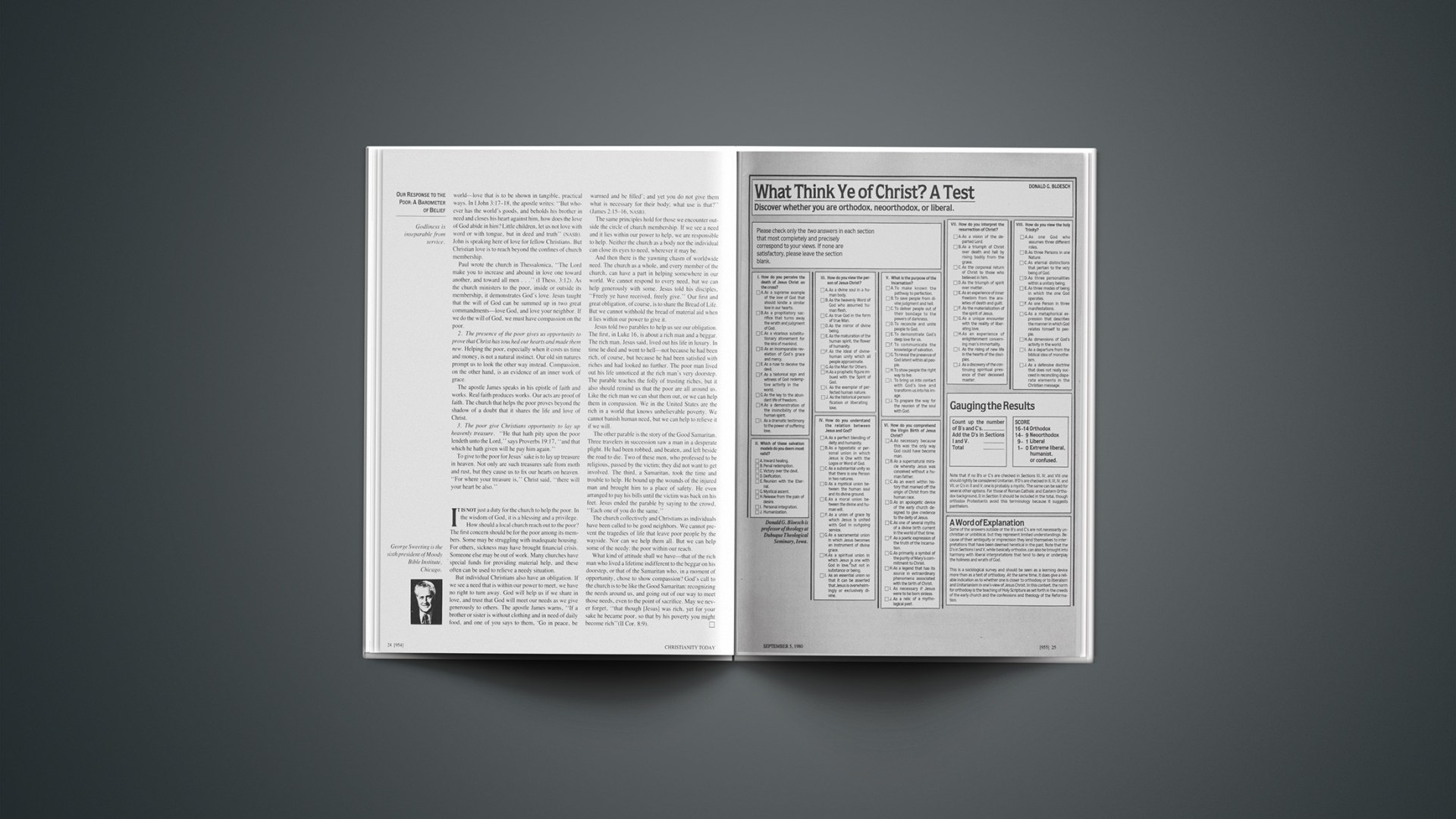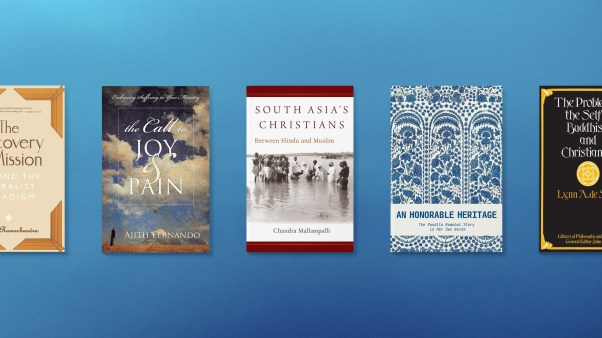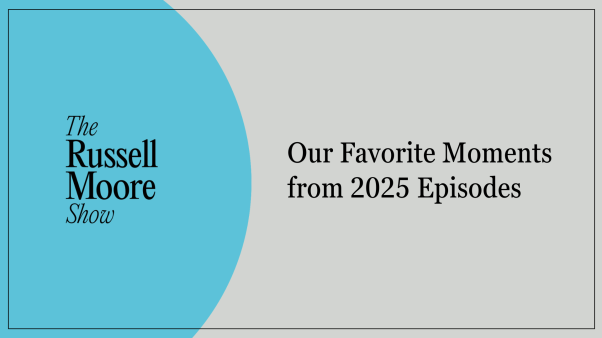Discover whether you are orthodox, neoorthodox, or liberal.
Please check only the two answers in each section that most completely and precisely correspond to your views. If none are satisfactory, please leave the section blank.
I. How do you perceive the death of Jesus Chrlst on the cross?
A. As a supreme example of the love of God that should kindle a similar love in our hearts.
B. As a propitiatory sacrifice that turns away the wrath and judgment of God.
C. As a vicarious substitutionary atonement for the sins of mankind.
D. As an incomparable revelation of God’s grace and mercy.
E. As a ruse to deceive the devil.
F. As a historical sign and witness of God redemptive activity in the world.
G. As the key to the abundant life of freedom.
H. As a demonstration of the invincibility of the human spirit.
I. As a dramatic testimony to the power of suffering love.
II. Which of these salvation models do you deem most valid?
A. Inward healing.
B. Penal redemption.
C. Victory over the devil.
D. Deification.
E. Reunion with the Eternal.
G. Mystical ascent.
H. Release from the pain of desire.
I. Personal integration.
J. Humanization.
III. How do you view the person of Jesus Christ?
A. As a divine soul in a human body.
B. As the heavenly Word of God who assumed human flesh.
C. As true God in the form of true Man.
D. As the mirror of divine being.
E. As the maturation of the human spirit, the flower of humanity.
F. As the ideal of divine-human unity which all people approximate.
G. As the Man for Others.
H. As a prophetic figure imbued with the Spirit of God.
I. As the exemplar of perfected human nature.
J. As the historical personification of liberating love.
IV. How do you understand the relation between Jesus and God?
A. As a perfect blending of deity and humanity.
B. As a hypostatic or personal union in which Jesus is One with the Logos or Word of God.
C. As a substantial unity so that there is one Person in two natures.
D. As a mystical union between the human soul and its divine ground.
E. As a moral union between the divine and human will.
F. As a union of grace by which Jesus is united with God in outgoing service.
G. As a sacramental union in which Jesus becomes an instrument of divine grace.
H. As a spiritual union in which Jesus is one with God in love, but not in substance or being.
I. As an essential union so that it can be asserted that Jesus is overwhelmingly or exclusively divine.
V. What is the purpose of the Incarnation?
A. To make known the pathway to perfection.
B. To save people from divine judgment and hell.
C. To deliver people out of their bondage to the powers of darkness.
D. To reconcile and unite people to God.
E. To demonstrate God’s deep love for us.
F. To communicate the knowledge of salvation.
G. To reveal the presence of God latent within all people.
H. To show people the right way to live.
I. To bring us into contact with God’s love and transform us into his image.
J. To prepare the way for the reunion of the soul with God.
VI. How do you comprehend the Virgin Birth of Jesus Christ?
A. As necessary because this was the only way God could have become man.
B. As a supernatural miracle whereby Jesus was conceived without a human father.
C. As an event within history that marked off the origin of Christ from the human race.
D. As an apologetic device of the early church designed to give credence to the deity of Jesus.
E. As one of several myths of a divine birth current in the world of that time.
F. As a poetic expression of the truth of the Incarnation.
G. As primarily a symbol of the purity of Mary’s commitment to Christ.
H. As a legend that has its source in extraordinary phenomena associated with the birth of Christ.
I. As necessary if Jesus were to be born sinless.
J. As a relic of a mythological past.
VII. How do you interpret the resurrection of Christ?
A. As a vision of the departed Lord.
B. As a triumph of Christ over death and hell by rising bodily from the grave.
C. As the corporeal return of Christ to those who believed in him.
D. As the triumph of spirit over matter.
E. As an experience of inner freedom from the anxieties of death and guilt.
F. As the materialization of the spirit of Jesus.
G. As a unique encounter with the reality of liberating love.
H. As an experience of enlightenment concerning man’s immortality.
I. As the rising of new life in the hearts of the disciples.
J. As a discovery of the continuing spiritual presence of their deceased master.
VIII. How do you view the holy Trinity?
A. As one God who assumes three different roles.
B. As three Persons in one Nature.
C. As eternal distinctions that pertain to the very being of God.
D. As three personalities within a unitary being.
E. As three modes of being in which the one God operates.
F. As one Person in three manifestations.
G. As a metaphorical expression that describes the manner in which God relates himself to people.
H. As dimensions of God’s activity in the world.
I. As a departure from the biblical idea of monotheism.
J. As a defensive doctrine that does not really succeed in reconciling disparate elements in the Christian message.
Gauging the Results
Count up the number of B’s and C’s.
Add the D’s in Sections I and V.
Total
SCORE
16–14 Orthodox
14–9 Neoorthodox
9–1 Liberal
1–0 Extreme liberal, humanist, or confused.
Note that if no B’s or C’s are checked in Sections III, IV, and VIII one should rightly be considered Unitarian. If D’s are checked in II, III, IV, and VII, or G’s in II and V, one is probably a mystic. The same can be said for several other options. For those of Roman Catholic and Eastern Orthodox background, D in Section II should be included in the total, though orthodox Protestants avoid this terminology because it suggests pantheism.
A Word of Explanation
Some of the answers outside ot the B’s and C’s are not necessarily unchristian or unbiblical, but they represent limited understandings. Because of their ambiguity or imprecision they lend themselves to interpretations that have been deemed heretical in the past. Note that the D’s in Sections I and V, while basically orthodox, can also be brought into harmony with liberal interpretations that tend to deny or underplay the holiness and wrath of God.
This is a sociological survey and should be seen as a learning device more than as a test of orthodoxy. At the same time, it does give a reliable indication as to whether one is closer to orthodoxy or to liberalism and Unitarianism in one’s view of Jesus Christ. In this context, the norm for orthodoxy is the teaching of Holy Scripture as set forth in the creeds of the early church and the confessions and theology of the Reformation.
Carl F. H. Henry, first editor of Christianity Today, is lecturer at large for World Vision International. An author of many books, he lives in Arlington, Virginia.










